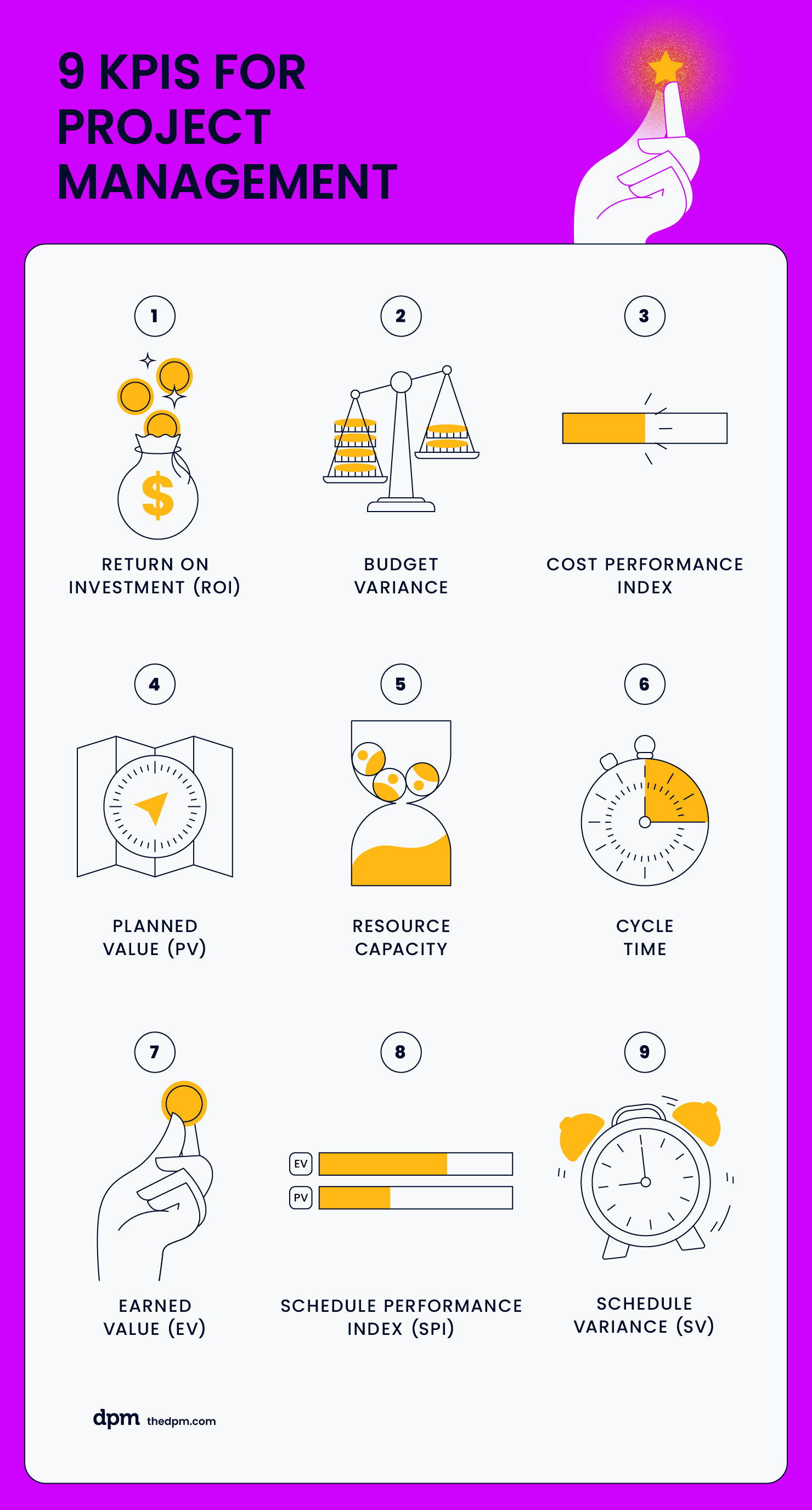Despite constantly keeping your eye on the ball, project managers might find it difficult to gauge the real health of projects. Are you on track or veering towards a cliff? Delivering value or just checking off tasks?
If these questions sound familiar, then you're in the right place. In this article, I'm going to unpack the top key performance indicators (KPIs) that have become a compass, an early warning system, and a report card, all in one. These are the metrics that help you stay on budget, on time, and on scope.
What are Project KPIs?
Project KPIs, or key performance indicators, are a set of quantifiable measures used to gauge the performance of a project over time.
These metrics help you monitor progress, identify trends, and make informed decisions about the direction of your projects. They provide tangible, concrete evidence of how you're doing—rather than relying on gut feelings or intuition.
9 Key Performance Indicators For Project Management
These effective KPIs help give a more comprehensive understanding of a project’s health, helping to ensure that you deliver on time, on budget, and within the agreed-upon scope. Let's take a closer look at each one.

1. Return on Investment (ROI)
ROI is a metric that's widely used to measure the probability of getting more out of the project that what’s been put into it (ie. a return on the money and effort that was invested in the project that made it worth it).
In project management, it helps you understand the financial viability of your projects. By calculating ROI, you can ensure that your projects deliver value and are worth the resources you're investing in like freelancers, graphic designers, and software developers. In terms of profitability, it’s one of the most important KPIs on a quantitative level.
2. Budget Variance
Budget variance (also sometimes called cost variance) is a measure of the difference between the budgeted cost of a project and the actual budget and costs incurred.
Did your project estimate predict you would spend $50,000 on a project, but you actually spent $75,000? Understanding the project budget and the possible variance is the first step to seeing what went wrong (or right) and how to adjust your project planning the next time.
3. Cost Performance Index (CPI)
CPI is like a grade for how well you're using your budget. It's the earned value (what you're getting out of the project) divided by the actual cost (what you're putting into the project). If the CPI is more than 1, that's awesome news!
It means your project is giving us more value than it's costing us. But if the CPI is less than 1, it's like a warning light flashing on your dashboard, telling you that your project costs are outpacing its value.
4. Planned Value (PV)
Planned value, or PV for short, is like your roadmap for the project. It shows you the value of the work you aim to have done by a certain date. Keeping tabs on PV is like checking your GPS during a road trip—it helps you to stay on the right path and avoid unnecessary detours.
5. Resource Capacity
Resource capacity is how much work your team can realistically handle in a given period. It's like knowing the size of a backpack before stuffing things into it. It’s the baseline or benchmark to use when planning resource allocation.
With this, you can make sure no one is overworked and you have the right manpower to tackle the project tasks. This way, you keep everyone fresh and maintain high productivity through proper resource management.
6. Cycle Time
Cycle time is the stopwatch for a task or a set of tasks. It tracks how long it takes you from start to project completion. Keeping an eye on your cycle times helps you to understand how quickly your team is working and lets you spot areas where you could speed things up a bit.
7. Earned Value (EV)
Earned value, or EV, is the actual value of the work you've done, measured against your budget. It's like your progress report, showing you just how much you've achieved so far. Regular check-ins on EV will help you to ensure your projects are staying on budget and not running off schedule.
8. Schedule Performance Index (SPI)
SPI, or schedule performance index, is the ratio of earned value to planned value. It's like a report card on how well you're using your time on the project. A SPI greater than 1 means you're ahead of the game, while a SPI less than 1 says you're falling behind. SPI really helps you keep the project timeline in check.
9. Schedule Variance (SV)
Schedule variance is the difference between earned value and planned value. It's like the alarm system that lets you know if you're running ahead or falling behind schedule.
By keeping a close watch on SV, you can act quickly if your project timing starts to slide, making sure everything gets delivered when it should. Is your team hitting milestones and staying on mark with the project schedule? Understanding that before the end of the project can be the key to a successful project overall.
Remember, there's no one-size-fits-all when it comes to KPIs. The metrics you choose should align with your overall project goals and help you track the specific outcomes you're aiming to achieve.
What Makes An Effective Project Management KPI?
An effective project management key performance indicator is one that is closely aligned with the project's strategic objectives. It should always be:
- clear and measurable: to track the project's progress and performance
- regularly updated: to ensure it reflects the current status of the project
- relevant and actionable: to make informed decisions and adjustments
- easy to understand: so all stakeholders can track the project's success
- linked to critical success factors: to determine the project's overall success
How To Track Project Management KPIs
Now that you understand what KPIs are and the ones that really matter for project management—what's the next thing on your to-do list? Keeping track of them in a way that doesn't drive you nuts.
There are tons of tools that can be a useful go-to for your project team. Picking the right project management tool can be a game-changer, making the whole monitoring and evaluating KPIs thing a whole lot simpler.
Here is a list of KPI tools both by type and by specific brand to start tracking all of your project management metrics:
KPI Tracking Tools by Type
There are a few different types of tools you can use to track KPIs, such as:
- Project Management Software: offers a centralized dashboard for real-time tracking of project progress, deadlines, and resource allocation, while providing key metrics like ROI, budget variance, CPI, PV, EV, milestone achievements and more.
- Resource Management Software: optimizes resource allocation and capacity planning, tracking metrics such as resource capacity, budget variance, and resource availability to ensure effective use of personnel and skills.
- Time Tracking Software: enhances accountability and efficiency by monitoring time spent on tasks and projects, offering insights into billable hours, time allocation, cycle time & more - crucial for accurate billing and process optimization.
KPI Tracking Tools by Brand
Here is my list of the best project management software organized by brand:
A lot of these tools lets you automate the tracking of KPIs like budget variance, cost performance index, and more. You can set up your dashboard to showcase these metrics, so you always have a quick snapshot of how your project is doing, right when you need it.
The right features can take complex project data and turn it into insights you can actually use. If you're interested in any of the above, we've created handy reviews and how-to-use guides for Asana, Wrike, Trello, and Monday.com.
FAQs About Project Management KPIs
As we continue to navigate important project management KPIs, it’s normal to have a few questions popping up. So, let’s tackle some of the most frequent ones to get things a bit clearer.
What Makes A KPI a Good Project KPI?
The best KPIs are specific, measurable, achievable, relevant, and time-bound (that’s SMART for short). It needs to line up with what you’re trying to achieve with your project and give you insights into whether you’re hitting your targets.
It’s also got to be actionable so you can make decisions based on it. And let’s not forget, a good KPI needs to be simple to understand and share—because what good is a KPI if it doesn’t lead to action?
What is the Difference Between KPIs and Metrics?
Yes, we sometimes use these terms as if they’re the same thing, but they’re not. A metric is just a measurement or a piece of data related to your project, like how many tasks you’ve knocked out or how many actual hours you’ve worked. A KPI, though, is a chosen metric that acts as a key sign of how your project is performing. So, every KPI is a metric, but not every metric is a KPI.
How Often Should KPIs Be Reviewed?
It depends on your project. If it’s a short-term project, it might be a good idea to take a peek at your KPIs every week. But for longer projects, checking in every two weeks or once a month might do the trick. The idea is to keep an eye on them often enough to spot trends and make corrections, but not so much that you’re wasting your time.
Are Project KPIs the Same Across Different Industries?
While a lot of KPIs like ROI, Budget Variance, and Schedule Variance are useful across the board, some are unique to specific industries.
For example, a software development project might keep an eye on things like bug rates and sprint velocity, while a marketing project would focus on things like the number of leads and conversion rates. The key is to pick the KPIs that fit your project and industry the best.
What’s Next?
We've just taken a behind-the-scenes tour of project KPIs and how they can act as our GPS through the wild and wonderful world of digital project management, steering us towards our goal.
For me, these KPIs have been like a trusty sidekick. They've helped me navigate the sometimes foggy landscape of project management, ensuring I have a clear picture of my project's health. They've become my secret weapon, shining a light on potential issues before they get the chance to stir up trouble.
If you enjoyed this article and found it helpful, don't miss out on more project management insights, tips, and stories from the field. Subscribe to The Digital Project Manager newsletter to continue learning and growing with us!


